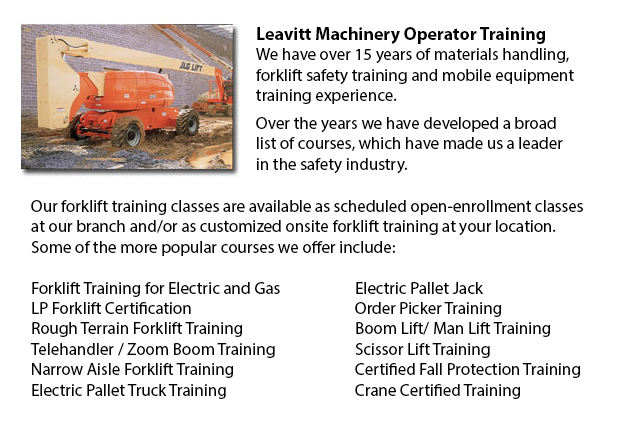
Toronto Aerial Lift Safety Training - There are roughly 26 to 30 construction deaths in North America due to the utilization of aerial lifts. Nearly all of the people killed are craftsmen like for instance laborers, painters, electrical workers, carpenters or ironworkers. Nearly all deaths are caused by tip-overs, electrocutions and falls. The greatest risk is from boom-supported lifts, such as cherry pickers and bucket trucks. The majority of the fatalities are connected to this kind of lift, with the rest involving scissor lifts. Other dangers consist of being struck by falling objects, being thrown out of a bucket, and being caught between the lift bucket or guardrail and an object, like for example a joist or steel beam.
The safe operation of an aerial lift needs an inspection on the following items before utilizing the device: emergency and operating controls, safety devices, personal fall protection gear, and wheels and tires. Look for possible leaks in the air, hydraulic fluid and fuel-system. Check the device for missing or loose parts.
The areas that worker would make use of the aerial device must be inspected thoroughly for potential hazards, such as bumps, holes, drop-offs and debris. Overhead powerlines have to be monitored and avoided. It is suggested that aerial lift devices be used on surfaces that are stable and level. Don't work on steep slopes which exceed slope restrictions specified by the manufacturer. Even on a level slope, brakes, wheel chocks and outriggers must be set.
Employers are required to provide aerial lift operators and maintenance mechanics with the proper instruction manuals. Mechanics and operators should be trained by a qualified individual experienced with the relevant aerial lift model.
Aerial Lift Safety Guidelines:
o Before operating, close doors and lift platform chains.
o Do not climb on or lean over guardrails. Stand on the floor of the bucket or platform.
o Stay within manufacturer's load-capacity restrictions.
o Use work-zone warnings, such as cones and signs, when working near traffic.
Electrocutions are avoidable if safety procedures are followed. Stay well away from power lines - at least 10 feet. Qualified electrical workers should de-energize and/or insulate power lines. Workers must use personal protective equipment and tools, like for example a bucket that is insulated. Nonetheless, a bucket that is insulated does not protect from electrocution if, for example, the worker touches a different wire providing a path to the ground.
When within the bucket, workers must prevent possible falls by securing themselves to the guardrails by using a full-body harness or a positioning device. If there is an anchorage in the bucket, a positioning belt with a short lanyard is adequate.
Tip-overs are preventable by following the manufacturer's directions. Unless the manufacturer specifies otherwise, never drive while the lift platform is elevated. Adhere to the device's vertical and horizontal reach limits, and never go beyond the specified load-capacity.
-
Toronto Wheel Loader Training
Toronto Wheel Loader Training - Normally, the different kinds of heavy equipment training are classed into 2 categories of machinery: those that have rubber tires and tracked vehicles. Tracked vehicles consist of items like for example excavators, cr... More -
Toronto Heavy Equipment Operator Training
Toronto Heavy Equipment Operator Training - Heavy equipment operator training facilities that provide good standards in the business, providing field performance tasks and added machinery training are really sought after training features. Students a... More -
Toronto Manlift Operator Certification
Toronto Manlift Operator Certification - We provide an aerial lift and scissor platform certification and training to empower the trainee with the general understanding and knowledge of the safe and efficient use of "Power Operated Mobile Work Platfo... More -
Toronto Aerial Boom Lift Ticket
Toronto Aerial Boom Lift Ticket - Aerial lifts can be utilized to accomplish a lot of unique duties done in hard to reach aerial spaces. Some of the odd jobs associated with this type of jack include performing regular preservation on structures with... More -
Toronto Heavy Equipment License
Toronto Heavy Equipment License - Obtaining a heavy equipment license is mandatory in order to operate these big industrial machinery. Certification could be acquired through a vocational school or private training. The license would enable the drive... More -
Skid Steer Loader Training in Toronto
A skid-steer loader is an engine powered equipment which consists of a small and rigid frame. It is outfitted together with lift arms that are utilized to connect to a large variety of labor saving tools and attachments. Typically, skid-steer loaders... More -
Toronto Aerial Lift Certification
Toronto Aerial Lift Certification - Aerial Lift Certification is for individuals who requires an in-depth understanding of aerial lift safety. Inspectors and operators, supervisors, maintenance workers and construction craftsmen should perform a cert... More -
Toronto Boom Lift Training
Toronto Boom Lift Training - Elevated work platforms, also called aerial platforms, allow workers to carry out tasks at heights which would otherwise be not reachable. There are different kinds of lifts intended for various site conditions and applic... More

Forklift Certification Toronto
TOLL FREE: 1-888-254-6157
Toronto, Ontario
forkliftcertificationtoronto.com
Email Us
About Us


